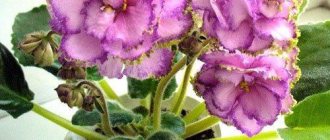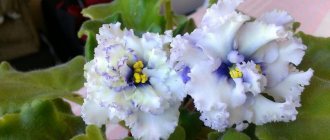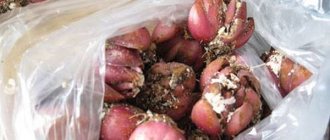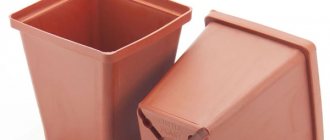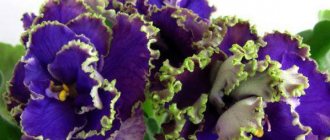Graceful, brilliant, with expressive decorative silhouettes, it is no coincidence that Uzambara violets occupy one of the leading positions in demand among flower growers who devote their preference, time and care to indoor plants.
Saintpaulia
draws attention to herself:
- Stunning caps of flowers;
- Beauty of lines and small dimensions;
- Saving space in collections;
- And an unpretentious character in terms of care.
As a successful example of varieties of domestic selection, flower growers can be offered for cultivation the DEO-Marzipan violet , which is as exquisite as the confectionery dessert that gave it its name.
IMPORTANT! The first violets, which appeared in the field of view of flower growers a little less than one hundred and fifty years ago, were also content with standard conditions for home collections and were distinguished by their compact structure and long flowering. But these were modest bushes with simple stars of purple flowers. And all the stunning variety of Saintpaulias was obtained later thanks to the merits of the masters of world selection.
Introduction
Violets are incredibly delicate flowers that have become real favorites of modern gardeners. They fit perfectly into the interior of a room and are able to decorate absolutely any room, no matter where the gardener plants them or displays containers with indoor Saintpaulias. Considering the demand for this plant, breeders also tried very hard to bring out the maximum number of incredibly interesting plants, varied in shape and color, that would be loved by everyone and could satisfy the needs and tastes of any modern gardener. This is how a variety of violet appeared called Peacock violet (RM-Pavlina) - this is an amazing and incredibly beautiful flower, which is characterized by expressive, abundant and very bright flowering. At the same time, the abundance of flowers and their brightness are perfectly combined with the tenderness and sensuality of the flower, with its elegance. Due to this, Saintpaulia looks great both as part of a single planting and as part of a group planting, which very often decorates window sills and balconies, office premises and, in general, any premises.
RS wild forest violet
There are more than five hundred varieties of violets in the world. They can be found in the wild and also bred as a garden or houseplant. Some types of violets are favorite plants in flower beds. Being an excellent honey plant, the flower is also used as a remedy. For medical purposes, the description of forest violet is suitable for the treatment of headaches, as an expectorant, anti-inflammatory, diuretic, disinfectant, sedative and blood purifier.
Tricolor violet can be used as a remedy to combat fever, allergies, or as a diuretic.
Violet RM Pavlina: Description of the variety
Violet Peacock: photo
The versatility of violets is another characteristic due to which violets are so in demand and loved by gardeners today. The flower of this particular variety of Peacock violet stands out against the background of many other varieties and varieties. In this article we will tell you in more detail why this is so, what are the features and characteristic features of this planting, and why it stands out so favorably among all other violets, which, at the same time, in terms of prevalence and popularity, could sometimes surpass Peacock. Also in the article we will touch on the features of growing this variety of Peacock, what are the characteristic features of agricultural technology, and how this plant manifests itself in a variety of conditions.
On the bush of the Peacock violet variety of indoor Saintpaulia, very large buds appear, which then bloom as incredibly attractive flowers. The center of the flower is painted white, and most of the petal is painted in very bright and unique, fancy shades. It can be blue or pink shades, as well as purple. In a combination of several shades, you can also notice how fancy patterns are formed on the petals, which look incredibly elegant and attractive, and they really attract the attention of gardeners or their guests. The texture of the flower is semi-double; many experienced flower growers and specialists also note that the saturation of the shades very often depends on the temperature conditions in which the crop grows, and whether the same favorable microclimate has been created for it, which has a positive effect on growth and development and, accordingly, on the decorativeness of culture. As we can understand, all these conditions and circumstances are created by the hands of the grower himself, so the state of the planting, its external characteristics and the ability to display excellent quality flowers will depend on him.
Violet Peacock: photo
The leaves of the Peacock violet are colored in the standard green color. If all the necessary conditions have been created for the plant, then it will certainly grow and develop correctly. Accordingly, a small homogeneous, uniform rosette is formed, which will become the center of growth and development of the planting. The shape of the leaves is oblong, slightly rounded, so they look very organic and gentle in combination with the flowers. The very first flowers may appear approximately nine months after the plant was planted in a container for further development, but this will only happen if the grower initially followed all the rules of agricultural technology and did everything possible to make the plant feel comfortable. If the care is correct, you will be able to observe very lush and attractive flowering, and due to the fact that the color of the plant is very original, this variety and these violets stand out against the background of many other varieties and varieties of Saintpaulias.
From an official point of view, this variety of Peacock violet, like many other indoor violets, belongs to the genus of herbaceous plants, which are united under the name “Saintpaulia”. All representatives of this variety also have a common feature - their shades are always very beautiful and expressive, and this is what makes them stand out against the background of many other plantings and plants. Also, plants in general equally need certain agrotechnical rules, care, and compliance with similar points, if we talk specifically about such procedures. We will talk about this in the same article, because in many ways it has an impact on the growth and development of plantings.
Outlining life phases
Saintpaulia "DEO-Marzipan" is almost no different in the change of periods of life from the standard scheme for most varieties of Saintpaulia, therefore it has simple care methods that differ only in small nuances.
Specifics of development in the room
The variety is characterized by fairly rapid growth, it is easy to care for, there is no need to create any special conditions. The only disadvantages are :
- Difficulty in forming leaves into a rosette;
- Weak peduncles.
CAREFULLY! Considering the problems with the growth of the rosette, which manifest themselves in the bending of the leaves, their clasping of the pot, as well as the reluctance of the leaf plates to immediately fit evenly into their places in the tier, you should carefully consider this phase of the life of Saintpaulia.
A particular difficulty lies in the fact that all leaf growth defects do not depend on the development conditions of the violet - “shaggyness” can occur:
- Like on a rack;
- Same thing on the windowsill.
But the violet still does not like bright light .
To create a decorative silhouette of a bush, experts advise using a rosette corset. Selecting a combination of care regimens can also help - it is different for each specimen and is determined experimentally.
To preserve strength and form a sufficient volume of green mass in young violets, sometimes it is necessary to forcibly remove some of the still unopened buds , since the variety loves to bloom and can do this almost without rest, interrupting for a period of no more than half a month.
The weakness of the peduncles affects the silhouette of the flowering specimen only at a young age. In adult bushes, each flowering is accompanied by the dissolution of a mass of flowers, which to some extent covers the fan-like disintegration of peduncles.
Growth to adult specimen
Since the development of the “DEO-Marzipan” violet occurs according to the classic laws for Saintpaulia, the time from baby to the first buds - a sign of the plant’s maturation - takes a standard number of months :
- If you take leaf babies, then no more than eight months;
- If you use the stepson from an adult violet - even less.
Specifics of reproduction
For “marzipan” Saintpaulias, experts do not recommend using seed propagation - you may lose the variety.
ADVICE! All characteristics of the variety will remain intact if the violet is rejuvenated. It can be carried out already in the fifth year of the plant’s life. To do this, cut off the top part of the Saintpaulia, root it and plant it in a suitable flowerpot. You can root the “head” of the violet immediately in a permanent place, in its pot.
The usual propagation of the variety occurs vegetatively :
- Sight babies;
- A shoot of an adult plant.
You should wait the children have their own roots
Effect of temperature on flowers
Abundant bud formation and massive flowering of violets require compliance with optimal temperature conditions . The varietal plant will be able to bloom even with slightly lower mercury readings, but the flowering will not show full beauty and volume.
Heat has a negative effect on the development of the flowering phase:
- Buds may form later;
- The flowering process may not take place during this period;
- Or the blooming flowers will be too small and deformed.
Marzipan violet requires good temperatures for comfortable flowering.
The structure of peduncle branches
A minor drawback of varietal specimens is considered to be thin and weakened peduncles , the strength of which is not enough to hold a cluster of double flowers in an upright position. The result is that all the corollas are neatly placed on the leaves, but with many flowers this defect can be partially hidden by the volume of the overall flowering.
Flowering form model
Due to the many blooming flowers and very weak peduncles, the flower cap of the violet looks more like a fan-shaped distribution of clusters of corollas over the entire surface of the leaves of the rosette. The flowering of the variety becomes much more abundant over time, which adds splendor and charm to the violet.
Flower lifespan
A distinctive feature of the DEO-Marzipan variety is the presence of only short periods of time for recuperation after flowering . This means an almost infinite number of flowers on a plant.
The variety in question blooms for a month.
by maintaining the decorative state for a long time - usually more than a month.
ATTENTION! The flowers do not wither for a long time due to their hard quality.
Peacock violet: growing a variety
Peacock violet: photo
All plants and crops that belong to the specified genus must be planted with sufficient lighting so that full daylight hours range from twelve to fourteen hours a day, no less. But at the same time, the plant must be protected from direct sunlight so that the sun does not cause a lot of damage to the leaf parts and flowers. Burns can not only spoil the external characteristics, but can also have a very negative impact on the immunity and stress resistance of the planting. Evening and morning light is not so aggressive, so it can quite easily touch the plant, and such sun rays are not burning, which means they cannot cause too much damage and harm to the planting. But daytime, especially midday, sun rays can have a very negative impact on such delicate creatures as violets.
Only by observing the lighting conditions, you can ensure that the flowering acquires a beautiful and expressive shade, and the same will apply to the color of the leaf part - the bushes will be very abundant, green, bright, in contrast with the color of the buds and inflorescences, the Peacock violet will stand out favorably against the background many other plants and will ultimately become quite a nice and attractive accent on window sills or in the decoration of any space, even a business office.
If the air temperature drops below fifteen degrees, the growth and development of the planting may slow down or stop altogether. In very hot and sultry periods, the violet will feel most comfortable at a temperature of 24 degrees, and when cold weather sets in, this indicator may change and drop. The main thing is to avoid sudden changes in temperature, since Saintpaulia will definitely not be able to survive this safely, and a situation may arise in which the plant will feel the most unfavorable. Therefore, it is best for the gardener to make sure that the plant feels as comfortable as possible when it comes to temperature conditions. Experienced gardeners, flower growers and experts in this field recommend not taking the bush outside, balconies or loggias when it’s hot, as the plants do not tolerate it very well, and diseases and deviations from the norm may begin to develop, especially when it comes to growth and development of Saintpaulia.
Violet Peacock: photo
Like many other indoor indoor flowers, violets of the Peacock variety are completely unable to tolerate sharp winds and drafts. Also, sudden temperature changes can affect their condition, so it is better to abandon any such experiments altogether, so as not to inadvertently cause enormous damage to the plant. Violets feel most comfortable in a compact container, and this aspect must be taken into account precisely when the gardener makes a decision regarding which pots and containers the indoor Saintpaulias will grow in. This condition is also very important in order for a sufficient number of buds to form on the bush, because the decorativeness of the plant, its bright and abundant flowering, which is so loved by gardeners and flower growers, will depend on this.
It is best to select small plastic cups for planting Peacock violets, but clay or ceramic pots can also be suitable, but here you should make sure that their surface is porous and allows oxygen to pass directly into the root planting system. The size of the container is another important aspect. As a rule, the container should be about three times smaller than the rosette of the violet itself, so that it develops normally, and so that the root system feels comfortable and cozy in this case. Of course, the composition of the soil in which violets grow is also of great importance, since in this regard plantings can be quite capricious and whimsical.
Substrate for violets PM Peacock can be purchased at a specialized store for gardeners, also at a nursery or on a farm. There it will have the most correct and balanced composition, and is also perfect for planting violet crops. The composition also includes all the most essential vitamins and minerals, microelements and components that have a very positive effect on the growth and development of the planting. They are necessary for feeding the bush and for it to develop, produce abundant flowering, be decorative and simply very attractive. In addition, the ready-made soil mixture purchased in the store is completely ready for use; it does not need to be hardened, disinfected or further processed.
The gardener can also prepare the soil mixture himself. In order to make it as suitable and rich as possible for violets, it is worth adding elements such as turf soil, leaf soil, humus and sand to the soil composition. All this is mixed very thoroughly so that the mixture is homogeneous and so that no layers form. Also, before using a soil mixture you have made yourself, it should be disinfected with potassium permanganate, and also calcined or frozen so that all microorganisms that have grown in the soil or its components die and do not cause any diseases of violets in the future. If you follow all the proportions, you can achieve excellent and very fertile results from the violets themselves.
Violet Peacock: photo
In addition, to make the soil even more saturated, you can also add a little bone meal and one spoon of superphosphate to the above components, which are considered ideal and at the same time completely safe additives. All these components must be mixed very thoroughly so that they are evenly distributed and evenly absorbed by all the plantings that the gardener carries out. Ideally, the soil for the PM-Pavlina violet should be breathable, airy and very light. As for acidity, this indicator must be very low, because only in this case will the plant feel most comfortable.
Of course, if you follow all the rules, then even a gardener who initially had no experience will be able to create his own soil, and this is the first time he decided to make a soil mixture for violets (and for plants in general) with his own hands. If a gardener decides to transplant a violet from one container to another, it is also recommended to install a good, high-quality drainage layer at the bottom of the pot, and also make several holes in the pot itself. Thanks to this, excess moisture will come out of the soil and will not stagnate in the soil, making it waterlogged. Then the root system will be safe, the risks that the roots will begin to rot and diseases will begin to appear will be reduced.
Care techniques in indoor culture
The violet has a non-capricious character - it develops well and gratefully blooms in endless waves in response to the careful and regular implementation of simple agricultural practices:
Saintpaulia needs proper care for good growth.
- The plant should be placed on a window facing west or east; specimens from windows to the north should be provided with additional rays with a diffuse spectrum, to the south - unobtrusive artificial protection is required;
- water Saintpaulia in small doses from the moment when slight drying of the upper volume of the substrate is visually clearly visible;
- It is best to apply additional fertilizing with mineral fertilizers
- Provide light to the variety predominantly during the day, long-lasting, with a spectrum of scattered rays;
- Control a constant heat level within +18 + 24°C ; eliminate sudden fluctuations in the temperature gradient;
- Plant the rosette in nutritious, permeable soil with good aeration; ensure the creation of a volumetric drainage layer;
- When transplanting , use transshipment more often if there are no special indications;
- Correct humidity indicators using any possible methods, avoiding only direct spraying of the bush.
Caring for planting violets RM Peacock
Violet Peacock: photo
The very first watering of Peacock violets is carried out after the plant has been transplanted. A transplanted plant is considered to be a plant that was purchased in the form of a rooted leaf, as well as in the form of a baby, and the planting materials are placed in a container where they will grow continuously. The violet should also not be constantly moistened, as this will lead to waterlogging of the soil and, as a result, the root system will be very painful and may rot. It will be sufficient to periodically add moisture to the soil, and keep in mind that this is usually done after the top layer of soil has dried out. Typically, it is recommended to moisten the soil on average once every ten days, but if certain microclimate conditions have been established, then watering can be done more often, or vice versa - a little less often. For irrigation, it is recommended to take settled water at room temperature,
Each plant needs the grower to add additional components and nutrients. Especially in this case, it is worth talking about how flowering shrubs need this. For Saintpaulias (indoor violets), it is recommended to use ready-made complex preparations and compositions that fully saturate the plant with nutrients, microelements, and macroelements. Typically, these compounds are applied when the violet devotes all its energy to increasing the leaf mass, and this happens approximately once every ten days. It is recommended to apply the compositions simultaneously with watering, so that the substances immediately disintegrate and quickly enter the root system. During the flowering period, it is best not to feed the bushes, since the violet at this moment accumulates all its strength, and it is better not to interfere with this process. Thus, the plant will feel much more comfortable and lighter, and the flowering will be bright and decorative.
Use of field violets in folk medicine
The plant contains essential oils, vitamins A, C, E and other beneficial substances.
Important! Due to the alkaloid content, wild Saintpaulia is poisonous, so it should be used with extreme caution and only under the supervision of a doctor.
The use of viola in medicine is possible after consulting a doctor
Forest viola can be used:
- to reduce temperature;
- for gargling a sore throat;
- as an expectorant;
- for headaches;
- as a diuretic, hemostatic, anti-allergenic, anti-rheumatic agent.
Note! In cosmetology it is used in creams to smooth out wrinkles and heal cracks.
Many people, having encountered a forest violet, do not think about the possibility of growing it on their property. However, wild varieties of viola can both decorate the garden and become raw materials for medicinal purposes.
Diseases and pests
Violet Peacock: photo
It’s worth talking a little about what diseases and pests can cause some harm to plantings of the Peacock violet variety. For example, flower growers most often encounter a disease such as powdery mildew, which most often occurs when growing violets indoors. The main symptom of the appearance of this disease is that white pieces begin to form on the green leaves of violets - a whitish coating, which just indicates that something wrong is happening to the plant, and it is urgently necessary to take certain measures in order to overcome the powdery dew. If suddenly the gardener notices that brownish marks have appeared on the leaves, then this is a sign that another rather dangerous disease has begun to develop on the plant - late blight. Due to late blight, the root system of the planting suffers greatly, which begins to actively rot, which means that if certain measures are not taken in time, the rotting will lead to the fact that the plant will die altogether, and it will simply be impossible to save it. In addition, diseases can spread to still healthy plantings, and they do not need much time for this. So as soon as the gardener notices signs of any of the listed diseases, it is necessary to immediately quarantine the plant, process it, remove the affected parts and do everything possible to save the violet from death.
If a white coating appears on the leaves or stems, this may also indicate that the plant has been infected with so-called gray rot. In this case, it is necessary to immediately remove all affected areas, as well as replace the soil so that it does not continue to progress the growth of the infection. After removing the affected parts, sections must also be treated with a fungicidal group of drugs. If suddenly the grower does not comply with the norms and watering schedule, this can lead to the plant becoming infected with a disease such as fusarium. As a result of this disease, the leaves and stems of the bush actively rot, in general the plant loses its attractiveness, its appearance becomes extremely painful, so it is immediately necessary to take a variety of measures so that this disease does not lead to the final death of the plantings.
Another disease is plant rust, which appears as small brown spots located on leaves and stems. Many diseases can be identified in time and treatment can begin with the help of treatment with special drugs that are specifically intended for this purpose. The most important thing is to follow the instructions for using the drug, since if you do not follow it, this may lead to the gardener introducing some drugs incorrectly. The concentration of the product will be applied to the leaf and stem parts, due to which the plant will experience even more negative sensations, may begin to hurt even more, and as a result will die altogether. It is also recommended to update the soil mixture in which violets grow, to disinfect the container so that the plant is in complete sanitation, and so that new foci of infection do not arise.
Mites are considered the most dangerous and destructive pests for Peacock violets; they can easily attack indoor plants, and given their microscopic size, the gardener will not immediately understand that harmful insects have settled on the plant. The presence of mites can be indicated by a cobweb that forms on the leaf part of the plant, and which just indicates that the pest has already managed to settle in the planting, so it is imperative to take some significant measures so that the plant does not die due to such an attack . Scale insects can also become a real and very serious problem for a gardener. On the body of the plant, scale insects leave an unpleasant and viscous mucus, which just means that a pest has infested the violet, and it needs to be dealt with urgently, otherwise it will begin to multiply quickly, and the plant will eventually simply die.
The green mass is targeted by thrips, which love to suck out all the juices and vital nutrients from it. In addition, thrips can also eat flowers. In this case, it is recommended to trim the plant, and its remaining parts are carefully treated with the help of specialized preparations that are intended to combat pests and microorganisms. The plant may also begin to rot, and nematodes become the cause of this negative manifestation. Experts usually compare nematodes and outbreaks of gray rot, but if microorganisms and pests suddenly appear on the plant, then rot will be a clear sign, but there will be no plaque on the violets. The bush will begin to fade very quickly, spontaneous outbreaks of rotting of leaves and stems will begin, and as a result, there is a high probability that the plant will be impossible to save if the grower does not take absolutely any measures in time. Usually, in this case, if the plant has been attacked by pests or has acquired a disease in a progressive form, then it is best to destroy the violet altogether. It is also not recommended to use earthen substrate after violets that were sick, since signs of pest activity will remain in it, which means this substrate is completely unsafe for future plantings. It is also thrown away.
It is recommended to regularly inspect your Peacock violet to see if there are any signs or symptoms of disease, or if the plant has been attacked by any pests or bacteria. If suddenly the florist discovers any deviations, he must immediately find out their nature and apply medications in accordance with the instructions for use. In general, regular inspections of plantings reduce the likelihood of developing diseases and also increase the chances of saving the plant. Instructions for using medications are an important key; you must not forget to read them, because if you use the medications and means correctly, you can save the plant and not cause any harm to yourself and your own health.
Features of flowering, growth and reproduction
Under favorable growing conditions and a high-quality choice of planting material, from a good flowering rosette in accordance with varietal characteristics, Saintpaulia transmits varietal characteristics well to young plants .
It grows easily, blooms for a long time and reproduces well.
How long does it take to grow an adult plant?
about 9 months pass from the moment the baby appears until it blooms By planting a stepchild from the mother rosette, you can expect the young rosette to bloom even earlier.
How are varietal characteristics transmitted?
Despite the fact that the variety has complex petal colors, the varietal characteristics are conveyed well . Sports don't happen often. Therefore, you can propagate the plant not only by stepsons, but also by leaf cuttings from the mother’s rosette.
The variety can be propagated using leaf cuttings.
Flowering in hot and cool conditions
Abundant flowering. The brightest spectacular flowering occurs at higher temperatures . When flowering in cool weather, a light version is obtained.
What do flower stalks look like?
Violet flower stalks:
- Sturdy;
- On thick legs;
- Not long;
- And they hold the thick cap well.
Is it possible to achieve cap flowering?
The variety blooms abundantly . From the very beginning, the variety produces many flower stalks with buds and a cap is obtained. The older the violet, the denser and larger its head of flowers.
This variety has abundant flowering.
Bud lifespan
The RM-Pavlina variety retains the freshness of the buds for a long time. Each flower blooms for more than a month.



